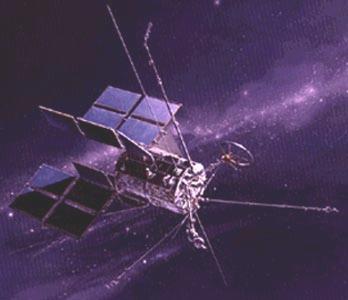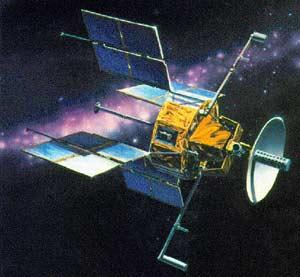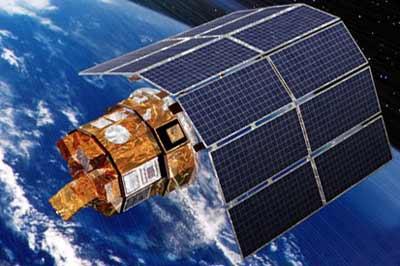STEP / TSX
The Space Test Experiment Platform (STEP) series of military satellites were launched to undertake a range of technology and scientific objectives. The series was later named Tri-Service Experiment (TSX). These satellites did not receive a designation in the S-for-Satellite series.
| Name | Intl. Designation | Launch | Re-entry | Notes |
|---|---|---|---|---|
| STEP-0 | 1994-017A | 13-Mar-1994 | Also known as USA 101 and P90-5 | |
| STEP-1 | --- | 27-Jun-1994 | --- | Failed to orbit |
| STEP-2 | 1994-029A | 19-May-1994 | Also known as P91-A | |
| STEP-3 | --- | 22-Jun-1995 | --- | Failed to orbit |
| STEP-4 | 1997-063A | 22-Oct-1997 | 31-Mar-2001 | |
| TSX-5 | 2000-030A | 7-Jun-2000 | Also known as P95-2 |
Launch dates of the STEP/TSX series
STEP-0
During the Cold War period there was a concern that both principal US launch sites could have been knocked out and the United States' space capability would have been hampered. To overcome this, it was proposed to develop a launch system which was semi-mobile in that it could be set up within eight days and would launch a satellite which was independent of ground controls. This concept evolved into the Technology for Autonomous Operations Survivability (TAOS) programme which used the Taurus launch vehicle.
 |
| Image: Author's collection |
| STEP-0 (1994-017A) |
Launched by a Taurus vehicle on 13 March 1994, the 503 kg STEP-0 satellite carried ten technology experiments, including two navigational systems which allowed the satellite to operate for several weeks without intervention of ground control, advanced radiation hardened processors and laser/radar sensors. STEP-0 was also known as P90-5 and USA 101.
STEP-1
 |
| Image: Author's collection |
| STEP-1 |
Launched by a Pegasus XL vehicle on 27 June 1994, the Space Test Experiment Platform (STEP)-1, which was also known as P90-1, carried six instruments to measure the propagation of high-frequency signals over the horizon through ducts in the ionosphere below 250 km, study the plasma instability which is believed to be the main source of high-latitude ionospheric irregularities, to support space based radar systems, over the horizon high-frequency communication systems and measure atmospheric drag. It had a mass of 348 kg. The launch vehicle was released from the L-1011 carrier aircraft off the Californian coast but the launch vehicle self destructed 2 minutes, 53 seconds after release and the satellite failed to orbit.
STEP-2
 |
| Image: Author's collection |
| STEP-2 (1994-029A) |
Launched on 19 May 1994 with a Pegasus launcher, the Space Test Experiment Platform (STEP)-2 carried the Signal Identification Experiment (Sidex). The satellite had a mass of 180 kg and was also known as P91-A. The launch vehicle was released from the B-52 carrier aircraft off the Californian coast.
STEP-3
 |
| Image: Author's collection |
| STEP-3 |
Launched on 22 June 1995 with a Pegasus launcher, STEP-3 was also known as P92-2. The 268 kg satellite carried:
- the Advanced Controls Technology Experiment
- the Erasable Disk Mass Memory instrument
- the Space Active Modular Materials experiment
- the Satellite Attach Warning and Assessment Flight Experiment
- the Space Qualified Optical Disk
The launch vehicle was released from the L-1011 carrier aircraft off the Californian coast but the Pegasus second stage failed and the satellite failed to orbit.
STEP-4
 |
| Image: Author's collection |
| STEP-4 (1997-063A) |
STEP-4 was launched on 22 October 1997 with a Pegasus XL launcher. This 400 kg satellite, which was also known as P95-1, carried three separate experiments to study the atmosphere and the ionosphere:
- the Digital Ion Drift Meter (DIDM) to study ion drift
- the Electromagnetic Propagation Experiment (EMPE) to aid study radio propagation through the ionosphere
- the Orbiting Ozone and Aerosol Measurement (OOAM) to study ozone and water vapour in the middle atmosphere
The L-1101 carrier aircraft had taken off from Wallops Island and the launch vehicle was released off the coast. The solar panels failed to deploy properly.
TSX-5
The 250 kg Tri Service Experiment (TSX)-5 satellite, also known as P95-2, carried two experiments. It was launched on 7 June 2000 with a Pegasus XL launcher, released from the L-1101 carrier aircraft.
 |
| Photo: Author's collection |
| TSX-5 (2000-030A) |
The satellite carried the Space Technology Research Vehicle (STRV)-2 experiment comprising a British developed medium microwave imager (MWIR) with an associated laser communications experiment. The MWIR consisted of a reflecting telescope, six selectable filters and long linear array detectors. The instrument tested the detection of military aircraft in flight by comparing two images taken over the same area at slightly different times. The Compact Environmental Anomaly Sensor (CEASE) tested equipment to measure the near-spacecraft environment.
Back to Directory of U.S. Military Rockets and Missiles, Appendix 3
Last Updated: 11 April 2005